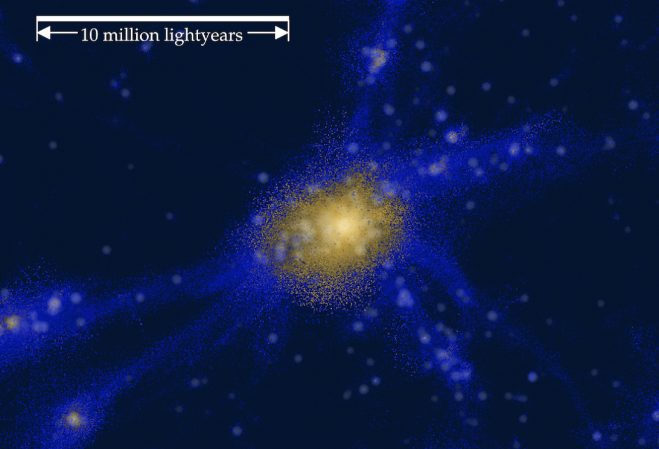Researchers have found the earliest evidence of parts of the universe that were heated to temperatures more characteristic of the intergalactic gas medium where most atoms reside in the universe today, reports a new study in The Astrophysical Journal Letters.
Approximately 90 of all atoms in the universe reside in the intergalactic gas that fills the vast expanses of space outside of visible galaxies. Today, this intergalactic medium exists in a hot, complex state with temperatures ranging from 100,000 degrees Celsius to more than 10 million degrees Celsius, which researchers often call the ‘Warm-Hot Intergalactic Medium’ (WHIM).

However, more than 10 billion years ago, a time when galaxies in the universe were at the peak of forming their stars, most of the intergalactic medium existed at comparatively cooler temperatures of less than 10,000 degrees Celsius, creating a more predictable and stable phase.
An international team of researchers led by Kavli Institute for the Physics and Mathematics of the Universe (Kavli IPMU) graduate student Chenze Dong and Project Assistant Professor Khee-Gan Lee has identified the furthest patch of the universe heated up to temperatures more characteristic of today’s WHIM at a time when the universe was only 3 billion years old. This region is a giant aggregation of galaxies known as ‘COSTCO-I’, a galaxy protocluster with a total mass of over 400 trillion times the mass of the Sun, and spanning several million light-years across, which was also discovered by Lee and a team of researchers at Kavli IPMU in 2022.
Although galaxy protoclusters in the distant universe such as this are regularly discovered, the team found something strange when they checked ultra-violet spectra covering COSTCO-I using the 10.3-meter diameter Keck-I Telescope at the W.M. Keck Observatory on Maunakea, Hawai’i.
Usually, the large mass and size of galaxy protoclusters would cast a large shadow when viewed at the specific wavelength of 121.6 nanometers, caused by the absorption by the neutral hydrogen associated with the protocluster gas.
But no absorption shadow was found at the location of COSTCO-I.
“We were surprised at the absence because hydrogen absorption is one of the common ways to search for galaxy protoclusters, and other protoclusters near COSTCO-I do show this absorption signal”, said Dong.
The absence of neutral hydrogen tracing the protocluster indicates the gas in the protocluster must be heated to possibly a million degrees above the cool state expected for the intergalactic medium at that time in the universe.
“If we think about the present-day intergalactic medium as a gigantic cosmic stew that is boiling and frothing, then COSTCO-I is probably the first bubble in the distant past that astronomers have observed during an era while most of the pot was still cold”, said Lee.
“The properties and origin of the WHIM remain one of the biggest questions in astrophysics right now, and to be able to glimpse at one of the early heating sites of the WHIM will help reveal the mechanisms that caused the intergalactic gas to boil up into the present-day froth. There are a few possibilities for how this can happen, but it might be either from gas heating up as they collide with each other during gravitational collapse, or giant radio jets might be pumping energy from supermassive black holes within the protocluster,” he said.
“The COSTCO-I is even interesting in terms of protocluster evolution. Astronomers normally look for protoclusters in galaxies or the intergalactic medium to find them. COSTCO-I, however, cannot be found by those traditional methods. The future PFS survey will be able to search for more such protoclusters, like COSTCO-I, and reveal their evolution,” said co-author and JSPS Overseas Research Fellow Rieko Momose.
The intergalactic medium represents the gas reservoir feeding raw material to galaxies, and hot gas behaves differently from cold gas in how easily it can stream into galaxies to form stars. Being able to directly study the growth of the WHIM in the early universe would allow astronomers to build up a coherent picture of galaxy formation and the lifecycle of gas that feeds it.
Kavli IPMU astronomers are currently heavily involved in the development of a powerful new multi-object spectrograph for the 8.2m Subaru Telescope on Maunakea, known as the Subaru Prime Focus Spectrograph (PFS). With Subaru PFS, astronomers will be able to map out 40 times larger volumes than in the current study and study the gas properties in hundreds of galaxy protoclusters.
Details of the study were published on March 14 in The Astrophysical Journal Letters.








